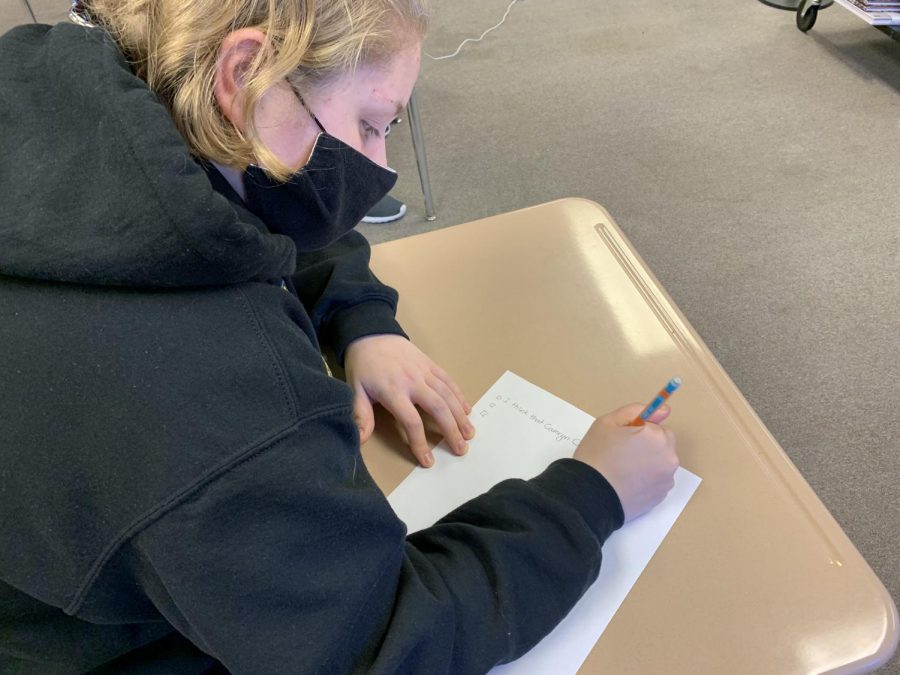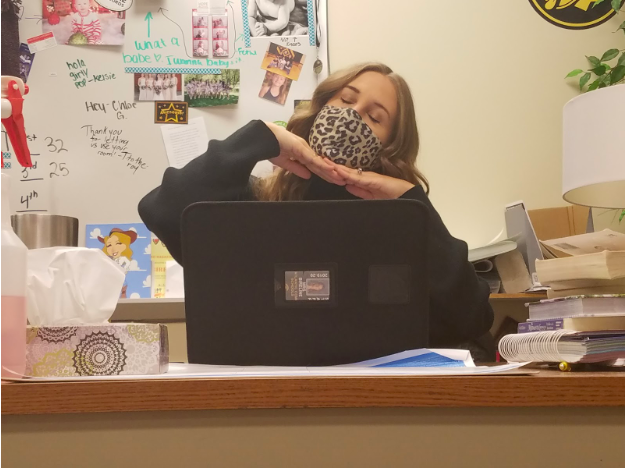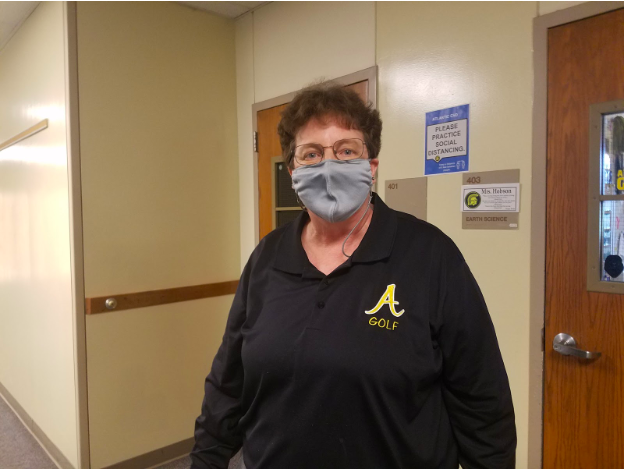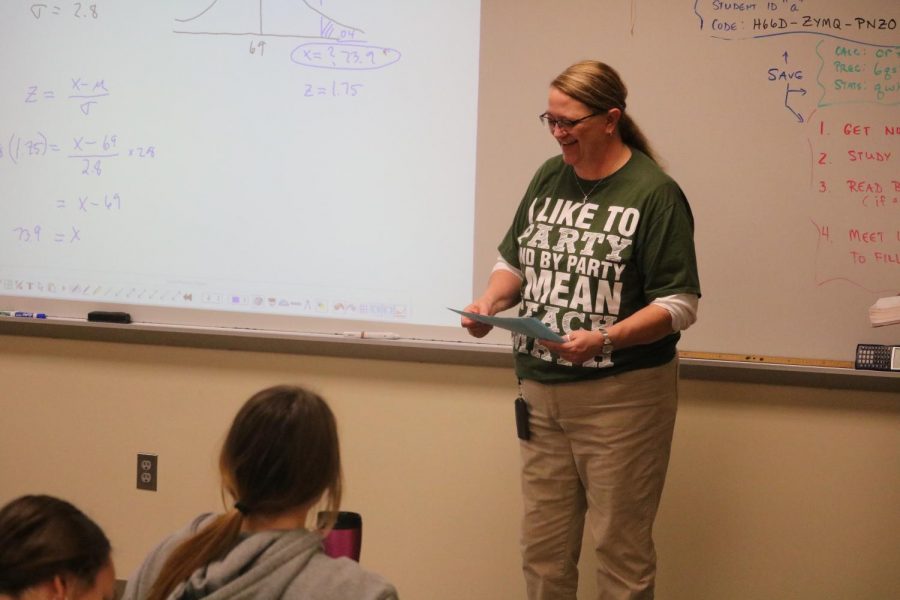Testing, 1, 2, 3
Tests are a foundation to the standard school system, but the style of test taken often depends on a teacher’s personal preference.
November 30, 2020
Tests come in all forms and styles. Each offers a unique twist to the standard method of assessment, which gives insight into the mind of the teacher providing the test.
Students in every grade have been subjected to “tests” in one form or another. However, the type of test they take tends to depend on the teacher of the class. No matter the subject, students are faced with a variety of assessments that are used to determine their learning in the classroom. Teachers themselves have their own views on the way testing is run and its benefits along with its downfalls.
History
Terry Hinzmann teaches world history classes.
Terry Hinzmann teaches world history classes. His old-school style was slightly shaken up due to COVID-19’s online learning opportunities, yet he has been adapting to the foreign style of online exams.
History teacher Terry Hinzmann prefers students to use pencil and paper when handing out tests. He says that it’s a “little old school” but that, “I just feel like it’s easier and more comfortable for me.” The impact of COVID forcing remote learners has changed Hinzmann’s style slightly, making him send out more essay-like questions for them to respond to. While he is not fully prepared to switch to online testing, the remote-learning experience is allowing him to get “more proficient at it.” His belief is that tests are a necessity in any form. “As educators, we need to have some type of assessments to report out on what students know and what they don’t know,” said Hinzmann.
Hinzmann uses essays on his test, though usually there are anywhere from four to six options on what a student can write about (correlating to the unit they’re working on.) “Part of my testing would be me asking my students what they know,” said Hinzmann. He also believes that he could “incorporate other skills” into tests, such as having the essays in order to improve student’s writing capabilities. Before the first test of the semester, Hinzmann goes over how to properly format an essay in order to teach kids the proper way to write an essay response.
The main advice he would give to students is for them to study in smaller portions rather than trying to study the entire thing on the night before a test. He says that the night before a test should be used for review instead of an attempt to ‘study.’ Hinzmann thinks that students should be able to apply the information they learn rather than relying on “rote memory” (memorizing just the facts without knowing why they’re memorizing the facts). Hinzmann said, “It’s the application of the knowledge they gained that is the real critical point.”
English
Emma Bireline teaches various English and elective classes.
With a number of electives along with core-classes to teach, Emma Bireline changes her testing style in order to best fit what the class is currently doing.
Using a variety of testing styles, English teacher Emma Bireline changes her method in accordance with the unit being taught. Units based around novels tend to have a combination of true-false, multiple-choice, and essay questions while her writing units are more essay-based. “It is just all dependent on what the specific objectives are for the unit.” Bireline finds assessments necessary as long as the teacher applied the knowledge gained from the data in order to “modify their teaching.” Bireline said, “If it’s just to put in a random grade then it’s stupid.” Her testing method has evolved over the years. “Teachers love to brag about how many kids are failing the class,” said Bireline, who was then led to believe that “the harder the class the better the teacher is.” “But then I realized that’s not true.”
If Bireline could change the testing system, she would “require teachers to present their objectives.” These objectives would then be used to measure a student’s learning and plan an ideal outcome. “Any test question on my assessments where 50% or more of the class gets it wrong, I take it out of the exam because that would probably indicate I didn’t do a good job of teaching it.” She believes that teachers should reteach data that students don’t seem to understand rather than trying to fail the entire class.
For her classes, Bireline uses an interactive notebook that students can refer to in order to see what their objectives are in order to prepare for the assessment. She also wants students to practice self-advocation. “If they feel like there’s a question on the exam that they didn’t learn, talk to the teacher about it.” The main issue Bireline sees students make is “believing that they don’t need to participate and attend classes to pass.” The notion that a student deserves an A simply by doing the assignment or test is also something that Bireline detests. “Students think that just because they completed something that it should be A quality, but A means you went above and beyond.”
Science
Kathy Hobson teaches earth science.
Teaching Earth Science, primarily to freshmen freshman, Kathy Hobson offer the use of science notebooks on her assessments.
Science teacher Kathy Honson also prefers the pencil and paper method (though has resorted to sharing documents for online learners). The evaluations, though, usually are composed of a variety of test styles (primarily essay/shot question) to meet the required standards. “Toughest part has been hoping that remote/quarantined learners are taking evaluations honestly since they can’t be monitored directly,” said Hobson. Because of this, she has allowed the use of their notebooks on tests.
Hobson enjoys the testing process at AHS’s individualism. “Our testing process at AHS is very individual– each teacher can decide how and when they want to test,” said Hobson. She landed on her own method of testing by attending various meetings with fellow staff and receiving input from professionals, allowing her to adapt them into her own unique style.
She recommends that students review activities and notes every night before an evaluation regardless of if they have homework or not. “Do some practice problems if formulas are going to be involved,” said Hobson. One of the most common mistakes she sees students make is failing to fully read through directions. This can lead to a lack of correct labeling (such as mL instead of grams) or students “making up their own words when a word list (is) provided.” Proofreading is essential to any test or exam.
Math
Sheila Hayden teaches high school and college level math classes.
Teaching high-level math courses, Hayden adopted her current pen-and-paper style of testing from her supervising teacher back when she was still student-teaching.
Calculating the perfect testing format, math teacher Sheila Hayden prefers the traditional pen and paper test, a style she adopted from her student-teacher days. Hayden adds a unique twist, however, in the form of a “thinking problem that is a little tougher than the rest.” In order for students to get full credit, they must show their work for each problem. The problems themselves are closely related to homework that is assigned prior. “I don’t believe in testing over something that wasn’t covered in class,” said Hayden. When classes shut down last year due to COVID-19, Hayden had her Calculus and Pre-Calculus classes test over the Zoom app in order to get their college credit and to be prepared for the following school year. “It wasn’t ideal, but we did the best we could with what we had.”
Hayden finds that in math particularly, assessments are needed often in order to check if students are able to move onto the next lesson. “My tests are usually just like the homework, so if you’ve done the work, the test should not present a problem,” said Hayden. She wishes that she could influence the number of absences that occur during assessments. “I cannot go over the graded tests until all students have taken it.” This causes delayed learning due to students being unable to see what they’ve gotten wrong until much later.
Students preparing for one of Hayden’s tests should revisit their homework, particularly on topics and areas that they know they’re struggling with. She also advises students to remember concepts that were taught “earliest in the unit” too. Hayden said, “The biggest error I see students making is just not studying. Anyone who says you cannot study for a math test is just giving an excuse for why they didn’t study.”




